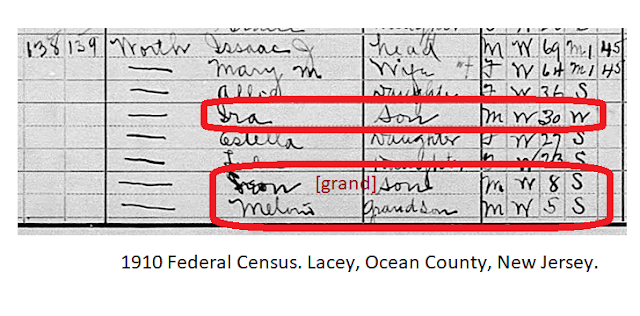My great-grandfather, Eugene Everett Cook (1898-1979), was born and raised in Newark, Essex County, New Jersey. He moved around within New Jersey and New York before retiring to Florida, where he died.
Although Cook is a common surname, I look into people with this surname who reside close to my family, especially if they share a given name as well.
Lawrence Eugene Cook (1872-1942) also lived in Newark, but was born in Swartswood, which is in Sussex County, New Jersey- fifty miles northwest of Newark.
 |
| Database Social Security Applications and Claims Index |
Lawrence's birth was not found in the birth ledgers circa 1872. This is not unusual. He also was not with his parents, John and Idell, in the 1880 census. Mistakes and omissions are not unusual.
 |
| 1880 United States Federal Census 101 Sheffield Street, Newark, Essex County, New Jersey Household of John Cook and Idell. No children. |
John Cook was born in England. My Cook line was in the United States when it was created in 1776. I figured there was probably no connection, so I did not venture further down that rabbit hole.
On Family Search, while browsing results of full-text searches for Eugene Cook in Newark, I found some documents about this other group of Cooks.
Lawrence Eugene Cook was adopted by John Cook and Idell. Lawrence and Idell were half-siblings. Their birth surname was Hibbler. Their father was Jacob Hibbler (1815-1880). He also used the spelling with one B, Hibler.
 |
| Petition of John Cook and Idell to adopt Lawrence E Hibbler, 1880 |
 |
| Order granting adoption of Lawrence E Hibbler by John Cook and Idell, 1880 |
John and Idell petitioned to adopt Lawrence on October 1, 1880. The family relations were explained. Idell was from Jacob's first marriage to Eliza Vliet (1820-1868). Lawrence was from Jacob's second marriage to Melinda Vanatta (1832-1872).
 |
| Family tree of Lawrence Eugene Cook, born Hibbler |
Using the surname Hibbler, Lawrence Eugene was found in the 1880 census living with his father, Jacob, and other members of the "Hibler" family in Newark.
 |
| 1880 United States Federal Census Hibler households at 31 Astor Street, Newark, Essex County, New Jersey |
Adoptions were not commonplace. Children could live with people other than their parents without any paperwork or judicial action. As for Lawrence Eugene, Jacob's advancing age and pending death probably prompted this adoption.
Jacob Hibbler died November 11, 1880. He was buried in Fairmount Cemetery in Newark.
 |
| Death certificate of Jacob Hibbler November 11, 1880 in Newark, New Jersey |
Although the petition for adoption stated, "said minor has no estate or property in his own right," Lawrence was left property in his mother's will in 1872.
 |
| Will of Melinda Hibbler Signed October 22, 1872 Stillwater, Sussex County, New Jersey |
Lawrence was only eight years old as his father was dying in 1880. Someone with legal authority needed to handle his share of his mother's estate; hence, this rare adoption was sought.
Lawrence Eugene Hibbler/Cook married Etta May Coursen (1874-1942). They had one daughter, Iliff Velmar Cook (1896-1961). The name "Iliff" is probably a family name. There is an Iliff Burying Ground in Sussex County.







































